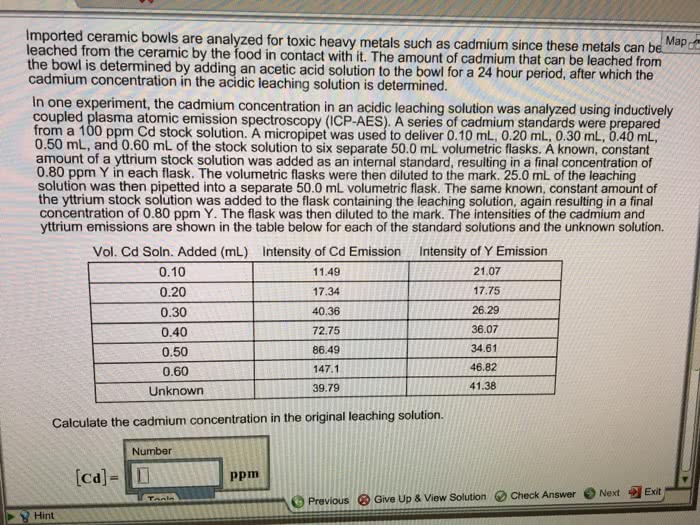The lead (Pb) content in the sample is less than 25, and the Atomic Absorption Spectroscopy (AAS) method is applied to determine its content. One method is used to determine the Pb concentration in the given brass sample. In order to determine the lead content in the sample, 1 g brass sample was digested in concentrated nitric acid and diluted to 100 ml. 25.0 ml of this solution was diluted to 250.0 ml. 25.0 ml diluted sample solution was pipetted into five 50-ml volumetric flasks. Then, 0, 5, 10, 15 and 20 ml of 50 ppm Pb standard solution were added to each of the 50.0 ml volumetric flasks containing the sample solution. Dilute all the five flasks to the graduation mark with deionized water. The following table is the experimental results by AAS.
Solution No. Vol. of diluted sample solution, ml Vol. of 50 ppm Pb, ml Conc. of Pb, ppm Absorbance 1 25.0 0 0.080 2 25.0 5.0 0.120 3 25.0 10.0 0.178 4 25.0 15.0 0.240 5 25.0 20.0 0.310
Show all of your calculation steps.
(a) (i) Find out the concentration of Pb (in ppm) for each of the solutions stated in the table above.
(ii) Draw a graph, and determine the unknown concentration from the graph. Then, calculate the %Pb present in the brass sample.
(b) Explain why the sample solution is not prepared separately, buy together with standard lead solution? Give TWO reasons to explain why the results obtained under this method are better than using external standard method.
The lead (Pb) content in the sample is less than 25, and the Atomic Absorption Spectroscopy (AAS) method is applied to determine its content. One method is used to determine the Pb concentration in the given brass sample. In order to determine the lead content in the sample, 1 g brass sample was digested in concentrated nitric acid and diluted to 100 ml. 25.0 ml of this solution was diluted to 250.0 ml. 25.0 ml diluted sample solution was pipetted into five 50-ml volumetric flasks. Then, 0, 5, 10, 15 and 20 ml of 50 ppm Pb standard solution were added to each of the 50.0 ml volumetric flasks containing the sample solution. Dilute all the five flasks to the graduation mark with deionized water. The following table is the experimental results by AAS.
| Solution No. | Vol. of diluted sample solution, ml | Vol. of 50 ppm Pb, ml | Conc. of Pb, ppm | Absorbance |
| 1 | 25.0 | 0 | 0.080 | |
| 2 | 25.0 | 5.0 | 0.120 | |
| 3 | 25.0 | 10.0 | 0.178 | |
| 4 | 25.0 | 15.0 | 0.240 | |
| 5 | 25.0 | 20.0 | 0.310 |
Show all of your calculation steps.
(a) (i) Find out the concentration of Pb (in ppm) for each of the solutions stated in the table above.
(ii) Draw a graph, and determine the unknown concentration from the graph. Then, calculate the %Pb present in the brass sample.
(b) Explain why the sample solution is not prepared separately, buy together with standard lead solution? Give TWO reasons to explain why the results obtained under this method are better than using external standard method.

